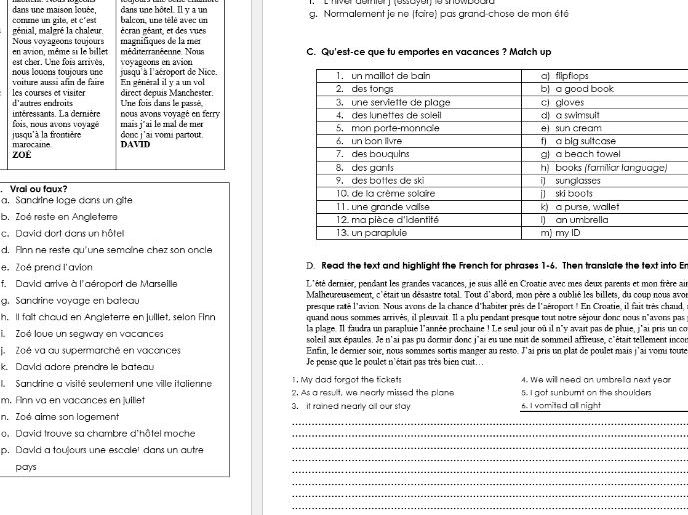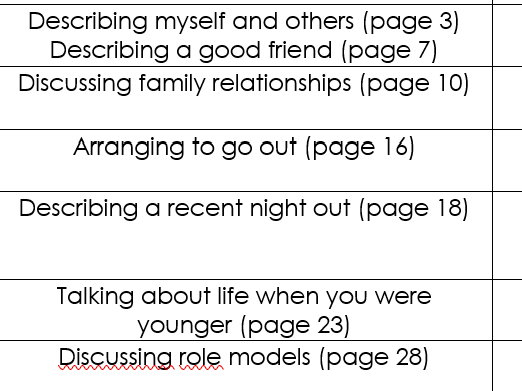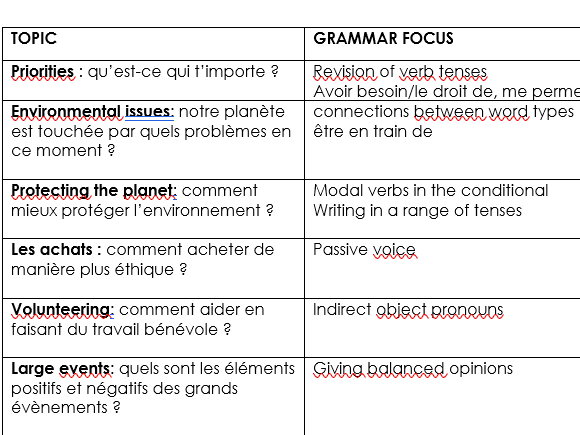
26Uploads
3k+Views
474Downloads
All resources

Passive voice (la voix passive)
A 3 page document explaining on the passive voice.
Tasks include:
highlight the passive voice
match up the split sentences (separate doc)
translate short sentences to French
Re-write active sentences in passive voice
re-write passive sentences in active voice
task on using “on” to avoid the passive
task on making verbs reflexive to avoid passive
task on verbs that use indirect object pronouns and cannot be made passive.
translate of longer sentences to French using all of the above.

Compound tenses in French
A worksheet for high achieving GCSE pupils or pupils on the A-level course.
This worksheet explains how compound tenses (perfect, pluperfect, future perfect etc.) are made in French.
Worksheet includes:
table of avoir/être auxilaries in five tenses
Verb translation to French
Sentence translation to French
Section on the three different “si” structures need at A-level with a gap-fill task
Short text on music where students must locate the different tenses

Perfect tense drilling worksheet (GCSE / A-level)
A 4 page document to thoroughly practise the perfect tense of the 30 most common verbs in French.
Page 1-2 : gap fill task
Page 3: (Orally) translate the verb only. Verbs only use avoir in this task.
Page 4: (Orally) translate the verb only. Verbs only use être in this task.
Page 4: Mixed practise of avoir/être verbs. Full sentence translation either orally or in writing,

Irregular present tense drilling worksheet (GCSE/ A-level)
A 4 page document to practise the 30 most common irregular present tense verbs in French.
Page 1-2 : 45 gap-fill sentences
Page 3: Oral translation to French of verb only.
Page 4: Oral/Writing full sentence translation.
Perfect for higher level GCSE or beginner Y12 French.

New GCSE: Free time activities: Est-ce que tu écoutes de la musique? + frequency adverbs
GCSE (new from 2024) aimed at higher level pupils.
The lesson covers music genres, frequency adverbs, ça me donne envie de / ça me rend structures, and basic negative structures.
It includes:
a phonics starter task
several reading, vocab and translation tasks
4 short listening tasks to improve listening skills
a writing task of 3 questions with some support

New GCSE Identity and Relationships: Qu'est-ce que tu fais avec tes amis?
GCSE (new from 2024) aimed at higher level students on the topic of activities with friends. The lesson also covers how to ask questions and direct object pronouns (le/la/les).
Lesson includes:
question formulation starter and listening task (teacher-led)
3 texts about activities with 3 close reading tasks
a slide on driect object pronouns (le/la/les) with 2 tasks
a quided writing task of 5 questions
a information-gap task (a survey - speaking and listening)

New GCSE Identity and Relationships: Tu t'entends bien avec ta famille?
Lesson powerpoint to describe family relationships using reflexive verbs. Lesson aimed at higher level pupils.
Lesson includes:
present tense -er -ir -re starter
2 reading texts with 6 activities
a sentence builder using reflexive verbs and justifications
4 drilling tasks on the sentence builder
a read aloud task
translate to English task

New GCSE identity and relationships: Tu étais comment avant?
Lesson for the new GCSE aimed at higher level pupils.
Lesson teaches pupils to talk about themselves when they were younger using the imperfect tense.
Lesson includes:
present tense “nous” starter
Quand j’étais jeune sentence builder
drilling tasks to practise language from the sentence builder
the full imperfect tense conjugation
imperfect translation, gap fill and manipulation
a short independent writing task

New GCSE Identity and Relationships Qui es-tu?
Lesson aimed at higher level pupils and includes a lesson powerpoint and a word document to print for the “find someone who” speaking task.
This lesson covers KS3 retrieval starter, a sentence builder that includes new GCSE vocab (coutnries, nationalities, hair, eye, facial features, sexual orientation, religion).
The lesson includes a sentence builder for speaking / conti-style tasks, as well as a 20 minutes close reading activity.
The lesson finishes with a writing task with support in the form of a gap-fill.

French idioms display
6 display posters of modern and widely used French idioms.
The posters have the expression in french, the literal translation and the meaning.
The idioms are:
j’ai d’autres chats à fouetter
il ne faut en faire tout un fromage
je fais la grasse matinée
les doigts dans le nez
arrête de raconter des salades
j’ai grave le cafard
Best used if printed and laminated pn A3 paper.

Les pièces de la maison - Rooms in the house
A one-page vocabulary drilling document to practise the rooms in the house,
including the following structures:
Chez moi il y a _____ pièces, dont….
Ma pièce préférée est……
The tasks include:
match up
break the sentences up into words
word anagrams
setence anagrams
a translation into French

Possessive adjectives in French
A one-page worksheet for year 7 or other beginner group on possessive adjectives in French.
This worksheet covers:
mon,ma,mes
ton, ta, tes
son sa, ses
It re-visit genders of nouns such as family members, then introduces the possessive adjectives with match up, translation and gap-fill tasks for pupils.

Avoir verb
a one page worksheet revisiting subject pronouns and introducing the verb avoir with some practise tasks.
Perfect for the first “verb” lesson with year 7, or other beginner group

Phonics in French
This is a one page worksheet for year 7 French students (or other beginner groups) to revise the alphabet and learn about accents (aigu, grave, circonflexe) and other French letter combinations such as the following:
oi
ou
é
qu
th
ai
au
ç
ille
There is a spelling task, a “write how it sounds” task, and an odd-one-out task.

Greetings in French Year 7 beginner
A double page worksheet introducing greetings and farewells with 6 consolidation tasks, including a mini-conversation for pairs at the end.
Perfect for that first lesson with year 7.

Adjectives in French
Full explanation and worksheet for regular adjectival rule sin French, along with a few irregulars (-en, -if, -eux).
Ideal for Year 7/8 French lesson, or revision at GCSE level.

Où habites tu? Hwo to say "in" in French
Beginner resource in French with a sentence builder on topic of "Où habites tu? ".
Explains when to use en/au/à/dans with some practise tasks.

Le grand large GCSE HIGHER LES VACANCES AQA MODULE 5
42 page booklet that can be used as base to teach entire topic of holidays (Le grande large - Module 5 - AQA GCSE) at higher level. Booklet includes sentence builders, vocabulary drilling tasks, readings, translations and suggested oral tasks. Booklet also includes grammar work on the conditional tense, reflexives in the perfect tense, the present participle, avant de + infinitive, demonstrative adjectives and pronouns and the pluperfect tense.
Booklet can be printed off and given to students. Sections can be printed if that is appropriate for your own groups. Booklet is not to be shared with other teachers.

Qui suis-je? GCSE FRENCH AQA HIGHER BOOKLET
Qui suis-je? AQA FRENCH HIGHER WORK STUDENT BOOKLET
27 pages. Includes a sentence builder for every unit, the corresponding grammar with practise tasks, vocabulary-drilling tasks, translations, writing questions and higher-level reading tasks.
This booklet be downloaded once, printed for students, and used for ever more as a basis to teach the entire first module qui suis-je of the AQA GCSE HIGHER spec.

Environment Social Issues Module 8 Un oeil sur le monde AQA French
Full booklet of sentence builders, drilling tasks, translations, reading tasks, grammar and writing tasks to go with the Module 8 AQA French HIGHER GCSE course.
Booklet can be used to teach full module, and can be given to students to help with individual revision or homework setting.
Aimed at high achieving pupils, although the resource is a word document so can be easily edited.




















